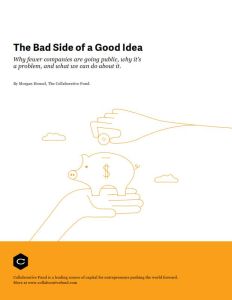Join getAbstract to access the summary!

Join getAbstract to access the summary!
Morgan Housel
The Bad Side of a Good Idea
Why fewer companies are going public, why it’s a problem, and what we can do about it.
Collaborative Fund, 2016
What's inside?
The initial public offering is no longer the only option to finance business growth.
Recommendation
For more and more companies, the road to future expansion does not include an initial public offering. According to this insightful article from journalist and private equity investor Morgan Housel, the short-term pressures of reporting to shareholders are driving CEOs to seek financing alternatives. And as the number of publicly traded stocks shrinks, investors must look to getting greater returns from fewer companies. getAbstract recommends this thought-provoking report to investors and to executives considering initial public offerings or private equity funding.
Summary
About the Author
Morgan Housel is a financial journalist, a private equity investor and a partner at the Collaborative Fund, a leading capital source for entrepreneurs.





















Comment on this summary